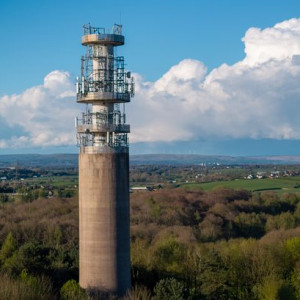The M60 landmark built to withstand a nuclear attack

The tower in Heaton Park has a remarkable secret history dating back to height of the Cold War
18:02, 05 Apr 2025
 Heaton Park BT Tower visible for miles across Manchester
Heaton Park BT Tower visible for miles across Manchester
Have you ever driven up the M60 motorway near Simister Island and gazed across Heaton Park[1], wondering what the story is behind the strange 238-foot tower hovering in view? Well, your curiosity ends here as we bring you the story of Heaton Park Tower--it's a tale filled with telephones, treachery, and the atomic bomb.
In 1961, the Soviets built the Berlin Wall, which became a symbol of the Cold War, dividing the East and the West. During the 1950s through to the late 1980s, the threat of nuclear war between the West and the Soviet Union hung over Europe and the rest of the world[2].
Article continues belowThe Cuban Missile Crisis of the 1960s was when many experts believe the world came closest to tipping over into nuclear conflict.
The arms race between the United States, the Soviet Union, and their respective allies during the Cold War only heightened geopolitical tensions and fear for the general public.
This would not end until 1991, when the Soviet Union's power and influence diminished, and its Communist regime imploded.
In Manchester, several relics of the Cold War era still exist today--Heaton Park BT Tower is one. Built in the 1960s, this multi-million-pound radio relay station facilitates telecoms between some of the region's largest businesses.
As one of three 'Radio Relay Stations', it connects with the BT Tower in London and the Birmingham radio tower to form BT's 'backbone system'. In 2017, Phil Worthington, a regional manager for BT, labels it as one of the company's 'prime assets' - but its history also offers a peek into Manchester's cold war past.
 Heaton Park Tower was built during the height of the Cold War
Heaton Park Tower was built during the height of the Cold War
The land on which it stands was leased from Manchester City Council in 1963 on a 99-year lease.
The towers were constructed according to the 'Chilterns Design', named so because they can transmit over the Chiltern Hills in the South East.
Eric Bedford, who served as the chief architect at the Ministry of Public Buildings and Works, was the brain behind this. Its first public mention came in the 1965 Defence white paper, where it was described as part of the backbone network.
The paper hints at plans 'to build up a special network, both by cable and radio designed to maintain long-distance communication in the event of an attack'. The concept was that it would handle traffic from the land-based telephone network if it was obliterated in an atomic attack.
 The tower was built to ensure Britain's communications network remained operational in the event of a nuclear attack(Image: Manchester Evening News)
The tower was built to ensure Britain's communications network remained operational in the event of a nuclear attack(Image: Manchester Evening News)
The tower's reinforced concrete base is engineered to endure a significant explosion, a design choice informed by studies conducted after the Hiroshima bombing.
This explains why it isn't constructed from steel lattice like the Winter Hill tower.
Previously, it was situated adjacent to a Royal Observer Corps Underground Monitoring Post - essentially an underground bunker.
This facility would have been staffed around the clock, with three officers responsible for evaluating and reporting on damage following a blast.
However, the post was deserted before 1995 when civilian members of the Royal Observer Corps were disbanded, and the corps was integrated into the RAF.
 The Heaton Park BT Tower is visible from the M60 motorway
The Heaton Park BT Tower is visible from the M60 motorway
Initial plans to construct more towers similar to the existing trio were made, but these became redundant with the development of more advanced nuclear weapons.
Today, it is a standard radio relay station, equipped with point-to-point microwave and other radio links.
Over recent years, many of its dishes have been dismantled, leaving just four.
Article continues belowSo, the next time you find yourself looking across at Heaton Park BT Tower, spare a thought for its intriguing past.
Join the Manchester Evening News WhatsApp group HERE[3]
References
- ^ Heaton Park (www.manchestereveningnews.co.uk)
- ^ hung over Europe and the rest of the world (www.manchestereveningnews.co.uk)
- ^ HERE (chat.whatsapp.com)